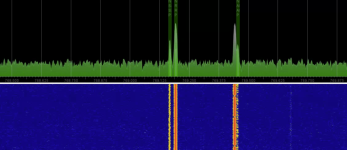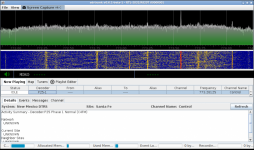You are using an out of date browser. It may not display this or other websites correctly.
You should upgrade or use an alternative browser.
You should upgrade or use an alternative browser.
New Mexico DTRS
- Thread starter beerzkool
- Start date
I was decoding it nicely with trunk-recorder on those very two sites last week. No luck with the SmartNet (decoded okay on UniTrunker, but not t-r, and seemed lightly used anyhow) nor the P25 800 (which seemed to be there but with no traffic).I am trying to setup sdr-trunk on a Raspberry-PI5 to listen to Santa Fe FD on the DTRS system. I did the radio reference import, but cannot get the channel to go active. I have tried the Tesuque peak and Santa Fe repeaters. Has anybody successful with New Mexico DTRS with sdr-trunk?
Here is a few screen shot shewing errors and channel config.
While I realize I’m talking about different software that pretty much does the same thing, please feel free to DM if you’d maybe like to compare notes. I found myself wishing I had a place to leave the PC there
- Joined
- Sep 4, 2021
- Messages
- 6
I increase the gain to the max, used a different antenna, and tried the whole setup out side, and get the same result. Although I did get better spikes, it still stayed idle and got the same errors.Keep the type as Phase 1 as the Control Channel is Phase 1.
I would look at your gain settings as there is a lot of noise showing on your waterfall. You should be able to make out distinct radio channels like the example below.
View attachment 170541
Attachments
- Joined
- Sep 4, 2021
- Messages
- 6
Thanks. Unitrunker does not run on a RaspberryPi and a Pi 5 is what I have available. If I'm wrong. let me know.I was decoding it nicely with trunk-recorder on those very two sites last week. No luck with the SmartNet (decoded okay on UniTrunker, but not t-r, and seemed lightly used anyhow) nor the P25 800 (which seemed to be there but with no traffic).
While I realize I’m talking about different software that pretty much does the same thing, please feel free to DM if you’d maybe like to compare notes. I found myself wishing I had a place to leave the PC there
I looked at trunk-recorder which does run on the RP-5, but it's a commend line based recorder, not a "Live scanner" type software. I'm looking for something with a GUI.
I increase the gain to the max,
If you're using the RTL-SDR Blog V4 dongles, try setting the Gain Control Master to "Automatic".
- Joined
- Sep 4, 2021
- Messages
- 6
I am using the V3, and I did try automatic. No go either.If you're using the RTL-SDR Blog V4 dongles, try setting the Gain Control Master to "Automatic".
Silent meaning they finally went E?
So it would seem. Note that the news release from the City of Las Cruces reported the system was "upgraded", and didn't mention encryption at all!
The new Talkgroups aren't always completely silent. Both the BCD996P2 and the BCD325P2 will occasionally play garbled audio for the duration of the call. In response, I created a System "Group" in each radio where I put the Talkgroup IDs that are silent or garbled. This Group is Locked Out, and whenever an ID silently halts "ID SEARCH" long enough for me to notice, I add it in, so I won't see it again.
You need to find the sweet spot with the gain. You need enough signal for the program to work but if you add too much gain, it adds too much noise and the program won't be able to hear the signal any more.I increase the gain to the max, used a different antenna, and tried the whole setup out side, and get the same result. Although I did get better spikes, it still stayed idle and got the same errors.
They were originally just going to upgrade but the main contractor is on a E kick convincing many to do it. Same one is doing Roswell's system and Eddy which Eddy is also following the E eventually. The dealer is a good guy but hell bent on E.So it would seem. Note that the news release from the City of Las Cruces reported the system was "upgraded", and didn't mention encryption at all!
The new Talkgroups aren't always completely silent. Both the BCD996P2 and the BCD325P2 will occasionally play garbled audio for the duration of the call. In response, I created a System "Group" in each radio where I put the Talkgroup IDs that are silent or garbled. This Group is Locked Out, and whenever an ID silently halts "ID SEARCH" long enough for me to notice, I add it in, so I won't see it again.
- Joined
- Sep 4, 2021
- Messages
- 6
IDK why, but today it's working! Now I gotta figure out how to get rid of the police!You need to find the sweet spot with the gain. You need enough signal for the program to work but if you add too much gain, it adds too much noise and the program won't be able to hear the signal any more.
ChrisABQ
...
Just create an alias file, enter in all the talkgroups for the police TG's and make sure "listen" and "record" are UN-checked.
From what I seen today it appears DASO, Anthony PD are using the dtrs and are encrypted on that end. VHF side just had Carrier key ups.
Talkgroups?From what I seen today it appears DASO, Anthony PD are using the dtrs and are encrypted on that end. VHF side just had Carrier key ups.
I observed them using their vp8000s which had digital audio coming from it. My issued radio only has the analog system. it was silent minus the carrier keyups. I dont know if they were testing or fully moved. But for sure Daso south was silent and their vp8000s were consistent with traffic while I was there.Talkgroups?
I see there are several new New Mexico DTRS sites showing up in the RadioReference database, including one called "Santa Fe Simulcast." I believe it's listed as Site 43 . . . does anyone know anything about this?Folks, there are several new sites on the air that haven't been tracked down and identified yet.
37
38
39
40
55
58
62
64
67
110
111
The new sites haven't yet reached the RR Master Database in Sentinel.
Thanks.
-Johnnie (KC5IGH)
ChrisABQ
...
Question: Why are they still on 800 Mhz?
Santa Fe's system is listed under the statewide DTRS, and I noticed that several of the frequencies are identical to those used in the old analog system that was kept in use for city services such as buses, trash pickups, snow removal, etc. Those frequencies are in the 850 to 859 MHz range and not in the statewide DTRS 700 MHz range.Santa Fe has it's own Simulcast system just like Albuquerque, Rio Ranchio, and Las Cruces.
Interesting developments these days. The Santa Fe City Police and Fire Departments migrated to the statewide DTRS, and I'm curious about if and how this simulcast system fits into it. I'm guessing it may be reserved for the city services organizations I mentioned above.
I've just tried programming it into my BCD436HP, but I think I'm too far away to hear anything. I'll take this scanner with me to Santa Fe tomorrow to see if it picks up any traffic.
Thanks!
-Johnnie (KC5IGH)
Last edited:
Good question.Question: Why are they still on 800 Mhz?
I just noticed that several of the simulcast frequencies were used in the old analog city services system that was left behind after the Santa Fe Police and Fire Departments migrated to the Statewide DTRS. I suppose it's possible that the new simulcast system will only be used by those city service organizations (trash pickups, buses, snow removal, etc.).
I just created a new favorites list and programmed those frequencies into my BCD436HP. I'll take it with me to Santa Fe tomorrow to see what I can hear.
-Johnnie (KC5IGH)
Similar threads
- Replies
- 7
- Views
- 1K
- Replies
- 12
- Views
- 604
- Replies
- 3
- Views
- 376
SDS100/SDS200:
Noise at end of transmission
- Replies
- 25
- Views
- 1K



